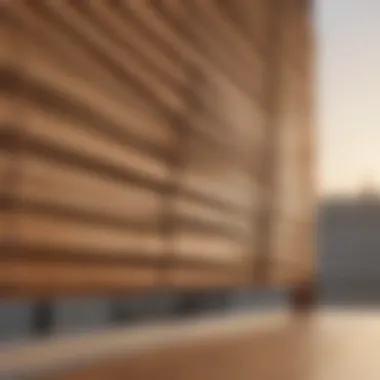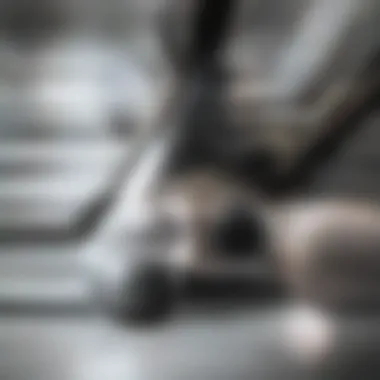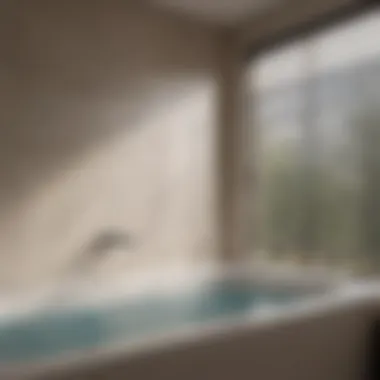Comprehensive Guide to Cleaning Blinds Effectively


Intro
Cleaning blinds is an often overlooked task in home maintenance. Blinds can accumulate dust, grime, and allergens. Regular cleaning not only improves the appearance of blinds but also promotes a healthier indoor environment. This guide offers a thorough exploration of methods to clean various types of blinds, addressing specific challenges and solutions.
Different material types of blinds require unique approaches to cleaning. Understanding how to handle each type is crucial. From wooden blinds that may warp when exposed to excess moisture to fabric blinds that could stain easily, each requires careful consideration. The following sections will provide detailed insights, including materials needed and steps to take in cleaning and maintaining blinds effectively.
Intro to Blind Cleaning
Cleaning blinds is often overlooked in home maintenance, yet it holds significant importance. The accumulation of dust, dirt, and allergens on blinds can impact air quality and overall aesthetics of the room. Regular cleaning not only enhances the appearance but also extends the life of the blinds. With countless styles and materials available, understanding how to maintain each type is critical for optimal performance.
Significance of Regular Cleaning
Keeping blinds clean is essential for several reasons. Firstly, clean blinds contribute to a healthier environment by reducing allergens that may cause respiratory issues. Secondly, they help maintain the functionality of the mechanism that operates them, which can be affected by dirt build-up. In addition, well-maintained blinds look more appealing, improving the overall ambiance of a room.
Types of Blinds
Understanding the various types of blinds can guide effective cleaning practices. This section looks at the main blinds categories to consider:
Vertical Blinds
Vertical blinds are characterized by their long slats that hang vertically. These are popular for large windows or sliding doors, offering excellent light control and privacy. Their design makes them easy to operate, providing a wide range of aesthetics with various materials available. However, they can collect dust easily, which makes regular cleaning necessary. They require special attention as the vertical slats can bend or break if not handled properly during cleaning.
Horizontal Blinds
Horizontal blinds have slats that are positioned horizontally. They are versatile and can fit almost any window size. One advantage is their ease of cleaning; a quick dusting is often sufficient. However, they can become difficult to maintain when blinds are left dirty for an extended period.
Venetian Blinds
Venetian blinds consist of horizontal slats that can be adjusted to control light. They are often made from wood or metal. Their classic look adds elegance to any room. However, they tend to show fingerprints and smudges more than other types. This necessitates a more rigorous cleaning routine, particularly for wood varieties, which can warp if exposed to moisture excessively.
Roller Blinds
Roller blinds feature a single piece of fabric that rolls up and down. They are known for their simplicity and minimalistic style. These types are easy to clean, usually requiring just a damp cloth. However, fabrics can stain more easily and require specific cleaners depending on the fabric type, making it crucial to identify the material before cleaning.
Fabric Blinds
Fabric blinds, as the name suggests, are made entirely from fabric and come in various styles. They offer soft aesthetics but often trap dust and allergens. Regular vacuuming is advised to maintain their appearance. It's important to determine the fabric type to use the correct cleaning solution, as some materials may require professional cleaning to avoid damage.
Identifying the Cleaning Requirements
Cleaning blinds involves more than just a casual wipe-down. Understanding the cleaning requirements is essential to maintain the visual appeal and longevity of your blinds. Each material type has distinct characteristics that impact cleaning methods. By correctly identifying these requirements, you prevent potential damage and ensure effective cleaning.
Assessing the Blind Material
The first step in identifying cleaning requirements is to assess the material of your blinds. Materials like vinyl, wood, fabric, or aluminum each have unique properties.
- Vinyl Blinds: These are generally easier to clean. They can withstand direct water exposure, making them suitable for wet cleaning methods.
- Wooden Blinds: Wood is sensitive to moisture. Use a dry cloth for dusting, and avoid soaking in water.
- Fabric Blinds: These require special care. Often, a vacuum or specific fabric cleaner helps to maintain their appearance.
- Aluminum Blinds: Dust can cling to aluminum, but they can be wiped down with a damp cloth, similar to vinyl.


Understanding your blind material ensures that you choose the right cleaning method, avoiding harm while effectively removing dirt.
Understanding Specific Stains and Dirt
Different types of stains and dirt require tailored approaches. Identifying them helps in selecting the most effective cleaning solutions. For example:
- Dust and Grime: Common on all types, these can be typically removed with a dry or lightly damp cloth.
- Water Stains: They can occur on moisture-prone fabrics. Using a specialized cleaner or spot cleaning solution would be ideal.
- Grease or Oil Stains: These can be tough. A gentle soap diluted with water often works best for removal.
- Mold and Mildew: Primarily on fabrics or in damp areas. Vinegar diluted with water can help eliminate these issues.
By understanding the specific stains on your blinds, you can choose appropriate cleaning products and methods, enhancing the longevity of your blinds and ensuring they remain looking fresh.
Remember: Regular assessment of both the materials and stains on your blinds facilitates a more systematic approach to cleaning, making maintenance less daunting and more efficient.
Essential Tools and Materials
The process of cleaning blinds is heavily reliant on the right tools and materials. Having the appropriate supplies ensures that the cleaning is efficient and effective. The choice of tools not only influences the quality of cleaning but also the ease with which it can be performed. Understanding which materials are most suitable can save time and effort, leading to better results.
Cleaning Supplies Overview
Dusters
Dusters are an essential part of cleaning blinds. The main characteristic of a duster is its ability to trap and hold dust and debris rather than merely pushing it around. This feature is beneficial, especially for delicate fabrics or intricate designs. When used properly, dusters can reach those hard-to-access areas without causing damage. However, one potential disadvantage is that they may require frequent washing to maintain effectiveness.
Microfiber Cloths
Microfiber cloths are another critical tool in the blind cleaning toolkit. Their key characteristic is the ultra-fine fibers that can clean surfaces thoroughly without scratching. This makes them suitable for most types of blinds, including wooden and plastic. One unique feature of microfiber cloths is their high absorbency, which means they can hold more liquid, thus reducing the need for excessive moisture. Nevertheless, care must be taken to avoid using fabric softeners when washing, as these may inhibit their performance.
Cleaning Solutions
Cleaning solutions play a pivotal role in removing stubborn stains from blinds. The key characteristic of these solutions is their chemical formulation, designed to break down grime and grease effectively. A good cleaning solution is popular because it can be tailored for specific materials, such as vinegar solutions for wooden blinds or specialized cleaners for fabrics. However, it is essential to consider the potential for chemical sensitivities or damage to certain materials when selecting a cleaning solution.
Bucket or Basin
A bucket or basin is an often-overlooked yet vital tool for cleaning blinds. Its primary function is to hold water or cleaning solutions, making it easier to dip cloths or sponges as needed. The key characteristic of a bucket or basin is its capacity, which can save time by allowing large batches of cleaning cloths to be soaked. A disadvantage might include the need for space, as a larger bucket can take up significant room during cleaning chores.
Sponge
Sponges are an everyday cleaning tool that can aid in blind maintenance. Their key characteristic is their versatility, as they can be used wet or dry depending on the cleaning requirement. Sponges can be effective for scrubbing away tougher stains that other materials might leave behind. However, they have some limitations; they need to be sanitized regularly to prevent mold or mildew growth, especially when used with water.
Protective Gear
Gloves
Gloves offer crucial protection during the blind cleaning process. Their main characteristic is to shield the hands from harsh chemicals in cleaning solutions. Wearing gloves is a beneficial practice as it keeps skin safe from irritation and potential reactions. A unique feature of gloves is their various styles; latex, rubber, or disposable types each serve different purposes. However, some people may find them uncomfortable or cumbersome while cleaning.
Safety Goggles
Safety goggles are also an important protective gear for the cleaning process. The key characteristic of goggles is their ability to protect the eyes from splashes of cleaning solutions. By wearing safety goggles, one can prevent irritation or injury, making them a prudent option for any cleaning task involving chemicals. The unique feature of safety goggles is their snug fit, which ensures no debris can enter from the sides. A downside can be fogging, which can hinder visibility during cleaning.
Step-by-Step Cleaning Process


A well-structured step-by-step cleaning process is essential for maintaining the appearance and functionality of your blinds. This systematic approach ensures no detail is overlooked, allowing for thorough cleaning without damage. The importance of this process lies in the organized way of addressing different materials and cleaning needs. An improper method can lead to ineffective cleaning or worse, damage to the blinds. Thus, understanding this process helps in preserving the integrity and extending the lifespan of your blinds.
Dusting Blinds
Dusting blinds is the first step in the cleaning process. Regular dusting prevents the accumulation of dirt and allergens, promoting a cleaner indoor environment. To effectively dust blinds, using a soft duster or a microfiber cloth is recommended.
- Frequency: A schedule for dusting should be established; doing it weekly or bi-weekly can be effective.
- Technique: Start from the top of the blinds and work your way down. This ensures that any dust that falls onto the lower slats is also cleared away.
Not only does dusting improve the aesthetic appeal, but it also sets the stage for deeper cleaning whenever needed.
Deep Cleaning Techniques
While dusting serves as a preventive measure, deep cleaning techniques are crucial for removing stubborn stains and grime. These techniques vary based on the blind material. Here are some effective methods that suit different blinds:
Using Water and Soap Solution
Using a mild soap solution combines effectiveness with simplicity. This method is particularly popular because most households already have soap on hand. A mixture of warm water and a few drops of dish soap is adequate.
- Key Feature: It is highly effective for plastic and vinyl blinds, removing grease and stains effortlessly.
- Benefits: It is safe, inexpensive, and non-toxic. Plus, it requires minimal equipment: just a sponge or cloth.
- Unique Downside: For fabric blinds, if not rinsed properly, leftover soap residue can lead to discoloration and attract more dirt.
Utilizing Vinegar for Stains
Vinegar is renowned for its stain-fighting properties. This method integrates an eco-friendly solution that can tackle tough stains without harsh chemicals. Using equal parts of vinegar and water can yield a powerful cleaning effect.
- Key Characteristic: Its acidity helps dissolve stubborn stains, especially on metal and plastic blinds.
- Benefits: Vinegar is safe, cost-effective, and leaves no chemical residue. It also deodorizes, which is a bonus after cleaning.
- Cautions: While vinegar is effective, its strong smell may be off-putting to some. Proper ventilation is advised to minimize discomfort.
Specialized Cleaners for Fabric Blinds
Fabric blinds require special care. Specialized cleaners designed for these materials help maintain texture and color. These cleaners often come in aerosol spray form, making application easy and quick.
- Key Feature: They target specific stains typical to fabric, such as water marks or food spills, preserving fabric quality.
- Benefits: These cleaners add a layer of protection that can prevent future stains, making regular maintenance easier.
- Disadvantages: The main downside is their cost. Specialized cleaning products can be more expensive compared to general cleaning supplies, but the investment can yield better protection and durability for your blinds.
In summary, the step-by-step process for cleaning blinds emphasizes the need for systematic and effective methods. Each technique serves a specific purpose and achieves cleaning without damage, which is vital for the longevity of your blinds.
Cleaning Specific Types of Blinds
Cleaning specific types of blinds is crucial in maintaining their aesthetic appeal and functionality. Each material requires a different approach to ensure proper care without causing damage. Knowing how to effectively clean vinyl, wooden, and fabric blinds enhances their appearance and prolongs their lifespan. Thus, understanding the specific cleaning needs can lead to better decision-making during the maintenance processes.
Vinyl and Plastic Blinds
Vinyl and plastic blinds are popular choices for both residential and commercial spaces due to their durability and low maintenance requirements. They are often used in rooms where moisture is present, such as kitchens and bathrooms, making them prone to dirt and stains.
The cleaning process for these types involves basic supplies. A mixture of warm water and mild soap can effectively remove grime from the surface. It is important to avoid harsh chemicals, as they can lead to fading or warping of the material. Use a soft cloth or sponge to gently wipe down each slat. In addition, ensure to clean any connected components like cords or chains. For tough stains, a diluted vinegar solution can be very helpful. Just be sure to rinse thoroughly afterward to prevent any residue.
Wooden Blinds
Wooden blinds add warmth and elegance to a space. However, they require more careful cleaning methods to avoid damage. Wood can easily absorb water, which may lead to warping or mildew.
Begin by dusting the blinds using a feather duster or a soft microfiber cloth. This process should be done regularly to prevent the build-up of dirt. For a deeper clean, use a wood cleaner specifically designed for blinds. Apply it sparingly on a cloth and wipe down each slat. Make sure to follow the wood grain direction for best results. If there are any stubborn spots, consider using a mild soap and damp cloth; however, avoid soaking the wood. After cleaning, always dry the surface immediately to maintain the wood's integrity.


Fabric Blinds
Fabric blinds add texture and softness to room design but can attract dust and stains more than other blind types. Their cleaning needs are unique due to the variety of fabrics used. When cleaning fabric blinds, first consult the manufacturer’s instructions for specific care recommendations.
A vacuum with a brush attachment is often the first step. This can effectively remove loose dust from the surface and in between folds. If stains are present, it is advisable to use a gentle fabric cleaner and a soft, damp cloth. Test any cleaner on a small, hidden area to ensure it does not discolor the fabric. For extensive upkeep, consider steam cleaning, which can effectively sanitize without saturating the material.
Remember: Regular cleaning and maintenance will not only keep your blinds looking great but also extend their lifespan significantly.
Post-Cleaning Maintenance Techniques
After executing a thorough cleaning of blinds, the emphasis should now shift to maintaining their condition and preventing future dirt accumulation. Post-cleaning maintenance is crucial because it helps in prolonging the life of your blinds, ensuring that they remain functional and visually appealing. Regular upkeep minimizes the need for intensive cleaning sessions and can safeguard against the build-up of dust and grime.
Preventative Measures
Implementing preventative measures can streamline the maintenance process. These strategies help in keeping the blinds clean with minimal effort.
Regular Dusting Schedule
Creating a regular dusting schedule is essential for keeping blinds in optimal shape. By incorporating dusting into your routine, you can inhibit dirt accumulation effectively. This is a straightforward approach, relevant for all types of blinds. A consistent schedule reduces the risk of allergens and dirt building up over time, maintaining a healthier environment in your home.
This method is characterized by its simplicity. Usually, a quick dusting once a week is all it takes to keep blinds looking fresh. Choosing tools like microfiber cloths enhances efficacy by trapping dust instead of scattering it around.
The main advantage of a regular dusting schedule is its time efficiency—less accumulation equals quicker maintenance. However, neglecting this practice could lead to more significant cleaning needs down the road.
Using Blinds Cleaner Spray
Using blinds cleaner spray is another efficient way to maintain cleanliness and appearance. These sprays are specifically formulated to tackle common dirt, dust, and stains found on various blinds materials. The targeted nature of these products makes them popular choices among homeowners.
A key feature of blinds cleaner spray is the ease of use. Typically, application requires only a few quick sprays followed by wiping with a cloth. This method is flexible, as it can be applied when you notice spots or stains, without the need for deep cleaning sessions.
One advantage of using blinds cleaner spray is its ability to leave a protective layer that repels dirt. However, selecting a compatible cleaner for your blinds' material is critical. Certain cleaners may contain harsh chemicals that could damage delicate fabrics or finishes. So, one must read the instructions carefully before use.
Inspection for Damage
Regular inspection for damage is an important aspect of maintaining blinds after cleaning. It’s essential to proactively check for wear and tear that could impact their functionality. Look for frayed cords, warped slats, or discoloration, as these issues can worsen if left unaddressed.
Conducting a thorough examination helps in early detection, which can save costs on repairs or replacements later. Keeping blinds in good working order means not just visual appeal but also operation without hitches. A little attention post-cleaning goes a long way in preserving the integrity of your blinds.
End
Cleaning blinds is not just about aesthetics; it serves critical functions that enhance the ambiance and functionality of a space. Regular cleaning practices ensure that your blinds remain in good condition, prolonging their lifespan while also preserving the air quality of your home or office. Dust and allergens settle in the blinds, and neglecting to clean them can lead to respiratory issues and other health concerns. Therefore, maintaining cleanliness is both a practical and health-conscious decision.
Recap of Cleaning Practices
In this guide, we have covered several essential cleaning practices to ensure your blinds are kept in prime condition:
- Understanding your blinds: Recognizing the type of blinds you have greatly influences the cleaning approach. Whether vinyl, wooden, or fabric, each type has specific cleaning needs.
- Tools and materials: Having the right tools is crucial. We explored various cleaning supplies such as dusters, microfiber cloths, and appropriate cleaning solutions to help tackle stubborn stains without damaging the material.
- Step-by-step process:
- Post-cleaning maintenance: Establishing a regular dusting schedule and periodically inspecting for damage can prolong the life and appearance of your blinds.
- Start with regular dusting to remove surface debris.
- Engage in thorough cleaning using suitable methods like soap solutions or vinegar for tougher stains.
- Pay special attention to the material of your blinds to avoid any damage during cleaning.
Final Thoughts on Maintaining Blinds
Maintaining your blinds requires diligence and regular effort, but it yields significant benefits. A consistent cleaning routine not only enhances the aesthetics of your space but also fosters a healthier living environment. Consider using specialized cleaners and following the specific guidelines suited to your blind's material.
Ultimately, well-kept blinds add value to your home while reflecting your attention to detail in home maintenance. Investing time in proper cleaning and maintenance will undoubtedly pay dividends in the form of durability and lasting beauty that enhances your overall interior design.















